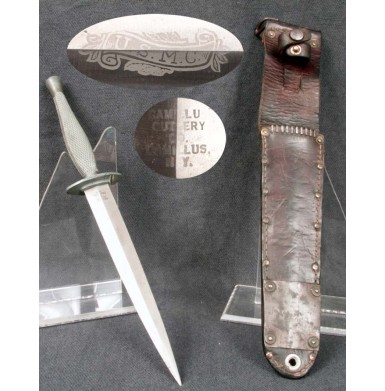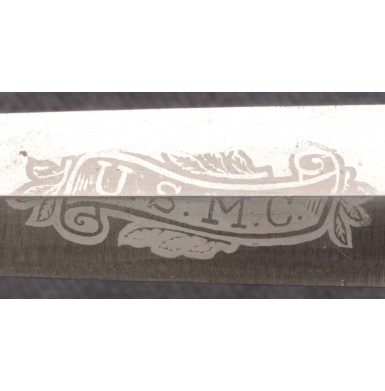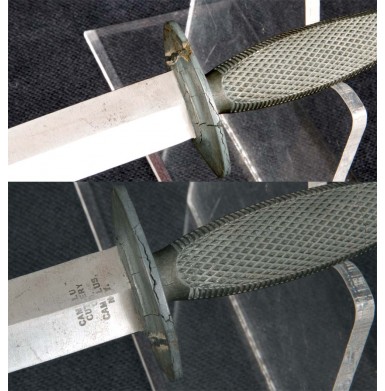Marine Corps Raider Stiletto with Fantastic Etched Panel
- Product Code: EWSK-1234-SOLD
- Availability: Out Of Stock
-
$1.00
The Marine Raider Stiletto is one of the rarest and most sought after of all the US combat knives from World War II. The Raider Stiletto has the distinction of being the first US designed fighting knife to be put into production after the United States entered the war. Lt. Colonel Clifford H. Shuey designed the knife in 1941. Shuey was the Officer In Charge of the Engineer Division, Quarter Master Department, Headquarters of the US Marine Corps. Lt. Colonel Shuey would go on to design several of the knives used by the USMC over the coming years and would retire from the Corps as a Brigadier General in 1956. Lt. Colonel Shuey based his knife upon the classic Fairbairn-Sykes fighting knife. Many members of the old 4th Marine Regiment had gained experience with due to the close combat instruction they had received from Fairbairn & Sykes while the regiment was on station in Shanghai, China. The Raider Stiletto, like the Fairbairn-Sykes knife, was a purpose made killing weapon with little value as a utilitarian knife or tool. The knife was designed to be lightweight, as well as cheap and easy to manufacture. It utilized a stamped steel blade that was then machined to a diamond shaped cross-section. The blade was polished to a bright shine and was etched with a USMC banner scroll on the blade as well as with the makers name and location on the ricasso. The handles were cast integrally onto the blade and were made of an from an aluminum-zinc alloy. The grip featured sharp diamond checkering that cast into the sides of the hilt, with serrations along the top and bottom. The grip was cast in a slightly oval shape, which fit the hand better than the machined round hilt of the Fairbairn-Sykes knife. The oval guard was integrally cast as part of the grip as well. The stamped steel stiletto blade was very thin at the end, and very delicate. In fact Marine Corps dictates specifically prohibited the throwing of the stiletto, as the impact would likely break the tip of the blade. In actual use, the stilettos had many of their tips damaged by using the knives as tools to open and pry things, and using them in any number of ways other than as a stabbing device. This inherent weakness in the blade design has made these rare knives even harder to find with full-length blades that have not been reshaped or “re-tipped”. Marine Major General (retired) Oscar F Peatros recalled of the Raider Stiletto in the book Bless “em All: The Raider Marines of World War II: "It was pointed out that it should never be thrown, as it was designed as a hand-held weapon to be used only in combat. It was also pointed out that it was brittle and would break even if just dropped, particularly the point." The aluminum-zinc alloy hilts had an inherent weakness as well. The alloy was very brittle and leached zinc ions, making them even very susceptible to cracking and decaying over time. Finding a Raider Stiletto without obvious cracks in the guard or grip is very difficult these days, and will only become harder as the grip alloys continue to age and essentially decompose. The Raider Stiletto was issued with a leather scabbard that would become the pattern for use with the V-42 Stiletto and the M3 Trench Knife. It was a two-piece scabbard, with the front and rear leather components joined by a combination of sewing and riveting. The scabbards were produced in two basic variants, with the early scabbards being of leather without a reinforcing tip and the later scabbards reinforced with staples at the throat and metal plates at the tip.
In early 1942 a contract for 5,000 of the Raider Stiletto’s was let to the Camillus Cutlery Company of New York. The Raider Battalions themselves were not officially designated until February of 1942. Camillus would receive an additional contract for 9,370 knives, bringing the total production of these rather scarce knives to only 14,370. The initial production knives reached the Marine supply depots (and Raider Battalions in training) in the summer of that same year. It was probably the fall of 1942 before any of the stilettos were issued to the Raiders who were already engaged in the Pacific. The Raiders were based on the famous British Commandos serving in China and were intended to conduct lighting-fast “behind the lines”, “hit and run” amphibious actions against the Japanese. During WWII the Raiders were instrumental in delivering stunning blows to the Japanese forces and fought gallantly in nearly every major Pacific landing operation from the Battle of Midway through Guadalcanal, the Solomon Islands Campaign, New Georgia and Bougainville. The four official “Raider” battalions were disbanded in January of 1944 and the two battalions in the process of being formed were reorganized into other standing Marine regiments. During their brief existence, a total of 7,710 Marines and 368 sailors served as “Raiders”.
The USMC Raider Stiletto offered here is in about VERY GOOD condition. The ever-fragile blade is full-length and measures 7 3/16” from the front of the guard to the tip, and has not been re-tipped. The Camillus factory specifications for the knife list the blade at a nominal 7”, but knife author and Guru MH Cole lists the blade as 7 “. I would assume that there was some minor variation in length during production, and +/- 1/8” would not be uncommon. The blade still retains the majority of its original brilliant factory polish, which makes it difficult to photograph accurately without excessive glare. The etched USMC banner scroll on the blade is about 90%+ visible, and is really crisp and clear. The scroll is in much better condition than typically encountered on a Raider Stiletto. The lightly etched Camillus makers mark on the ricasso is in wonderful condition as well, and is about 80%+ visible. The five lines are still quite legible and read: CAMILLUS / CUTLERY / CO / CAMILLUS / N.Y.. The only portions of the maker mark that are worn or difficult to read are the “S’ at the end of Camillus, which is almost entirely missing and the “CO” line, which is a little light. The cast alloy hilt is in about GOOD+ condition and is the weak point in the condition of the knife. The hilt retains very crisp checkering, but like so many Raider stilettos the hilt and guard show a significant number of visible cracks. The hilt has a lovely dull pewter-gray color to it and shows some very light patches of white oxidized leaching, scattered along the grip. The guard / hilt / blade junction shows numerous minor hairline cracks and several more major ones that have opened up a bit. There is also a small amount the guard material missing. There is an area of discoloration through one of the larger guard cracks that may be the result of the ionic leaching, or could be a repair to stabilize the crack. There are also a handful of more minor cracks evident in the hilt and the pommel cap areas of the grip. These are much finer stress cracks and seem relatively stable. Thankfully, even thought the hilt (and especially the guard) does show some deterioration, the grip and hilt seem stable and with careful handling they should allow you to enjoy many years of display of this rather scarce knife. The wonderful condition of the etching and the full-length unaltered blade help to make up for the common hilt deterioration. The knife is retained in the correct, later production leather scabbard. The scabbard features both the stapled throat reinforcements and the pair of riveted metal reinforcement plates on the tip. All of the scabbard stitching is tight and strong and all of the rivets are present. The scabbard is completely unmarked, as it should be, and bears no US Ordnance Bomb marks, which would be indicative of the M-6 scabbard for the M-3 trench knife. The leather of the scabbard remains pliable and is in good shape, with a dark brown, aged color to it. The top portion of the scabbard retains the original M-1936 pistol belt hook and the correct, original hilt retention strap. The strap is the correct, short pattern snap strap that is not long enough to secure the hilt of an M-3 trench knife and could only secure the narrow Raider Stiletto hilt. The rear of the scabbard has the initials R.K painted on it with very old white paint, which has discolored with time. These are likely the initials of the Raider who carried the Stiletto during World War II.
Overall this is a very nice displaying example of a scarce and desirable US WWII combat knife. USMC Raider Stiletto’s do not appear on the market for sale very often and due to the numerous factors that affect their durability, they are often in rather rough condition when they are found. The hilt of this knife is in very typical condition for a well cared for Raider Stiletto, with the usual decomposition that is typical of alloy used to manufacture it. The blade, however, is tremendously better than is usually encountered with these knives, as it is full-length and retains an excellent Marine Corps etched scroll and a very fine Camillus makers mark. With minty USMC Raider Stiletto’s regularly being priced in the $2,500+ range, this is a very respectable example that is 100% complete, correct and original and will display very well for a much more reasonable price.
SOLDTags: Marine, Corps, Raider, Stiletto, with, Fantastic, Etched, Panel








